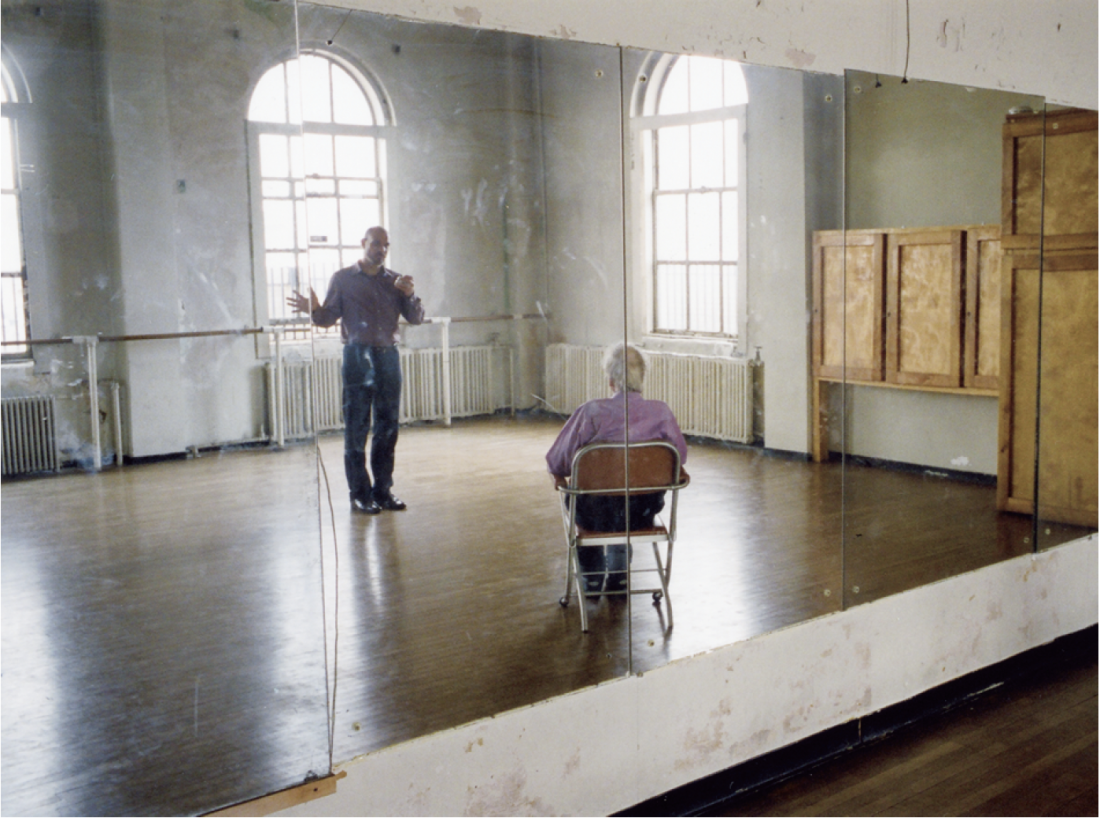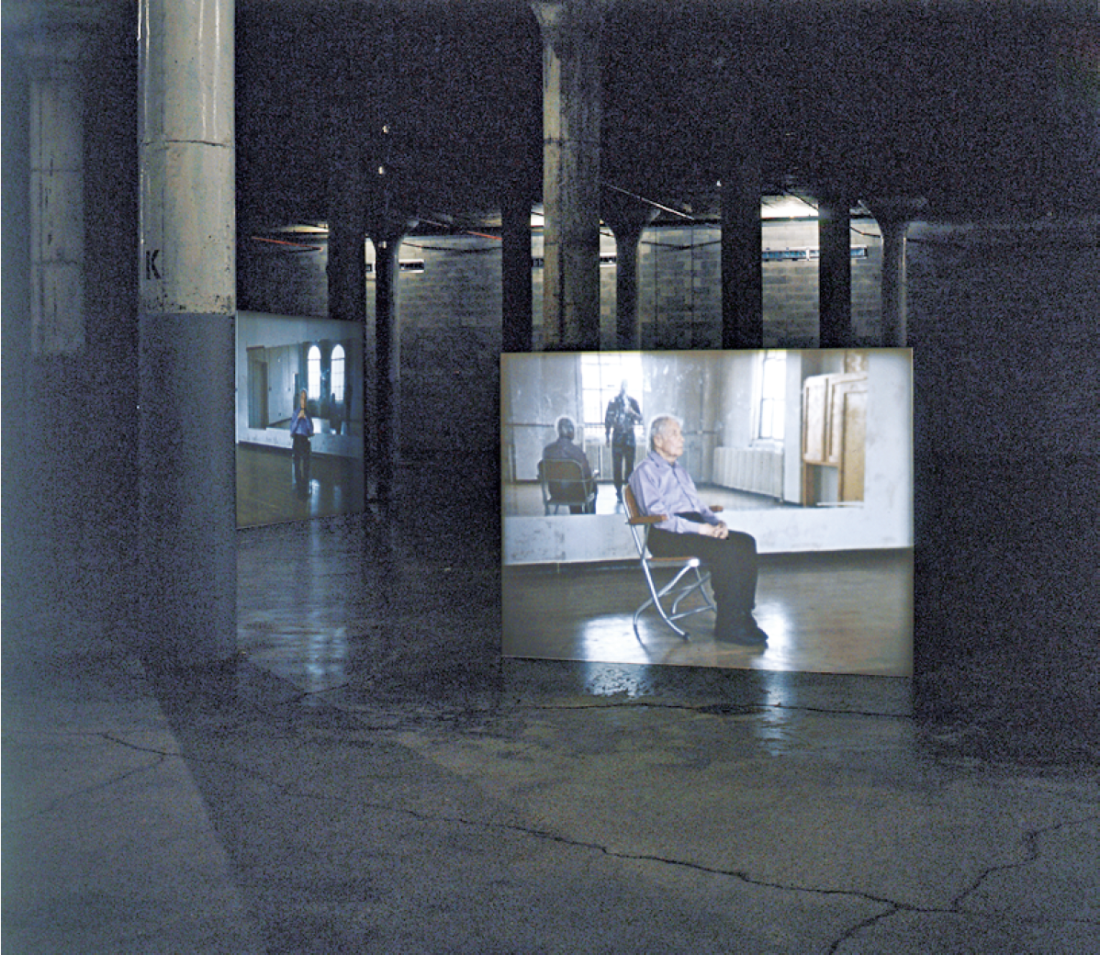Tacita Dean
Tacita Dean’s landmark six-film projection titled Merce Cunningham performs STILLNESS (in three movements) to John Cage’s composition 4’33” with Trevor Carlson, New York City, 28 April 2007 has varying levels of accessibility—and several orders of achievement. It is at once an unspoken eulogy for John Cage (d. 1992), a moving memorial to Merce Cunningham, the cutting-edge choreographer and dancer who passed away this past July, and resonant scaffolding for a filmic phenomenology of loss and mourning.
In 2007, British artist Dean asked Cunningham to choreograph John Cage’s composition 4’33” for a cinematic art piece. That composition—a 4-minute, 33-second period of silence performed in three movements—is seminal in the history of music and has been the subject of exhaustive analysis.
How could Cunningham refuse to choreograph the sounds of silence? After all, Cage had been his life partner and frequent collaborator for decades. At 88 years old and confined to a wheelchair, he signalled his acceptance and, on April 28, 2007, in the New York studios of the Merce Cunningham Dance Company, collaborated gamely with Dean as she shot six thematic films of his performance of Stillness.

Merce Cunningham performs STILLNESS (in three movements) to John Cage’s composition 4’33” with Trevor Carlson, New York City, 28 April 2007 (six performances; six films), 2008. Installation view at Dia: Beacon, Beacon, NY. Courtesy the artist, Marian Goodman Gallery, New York and Paris, and Frith Street Gallery, London.
This remarkable choreographic counterpart/counterpoint to 4’33” (pronounced Four minutes, thirty-three seconds or, as the composer himself preferred, Four, thirty-three) is a tripartite-movement composition for any instrument (or combination thereof). Notably, the score stipulates that the performer not actually play the instrument for the duration of the piece. Thus, silence is enacted, and no intentional deviation is permitted (although the listener, who is the ultimate referent here and not bound by any vow of silence, is hopefully complicit).
As we entered the darkened exhibition hall, we realized that the fixed camera always remained focused on Cunningham. He sits in a chair throughout, almost motionless before a wall of mirrors. I say “almost” because, while he seemed to be static, there were subtle reminders that these are not freeze frames but images shot in real time (Cunningham twitches occasionally and, upon close inspection, trembles throughout). The three internal parts are marked by the presence of Trevor Carlson, director of the Cunningham Dance Company, who makes a signal gesture that marks them. To relieve any stale appearance of sameness, each performance has been filmed from a discernibly different camera angle and the performer is seen at actual 1:1 body scale.
Cage’s 4’33” was first performed in upstate New York in 1952 and always remained the composer’s favourite piece in his entire corpus. Constantly spurring him on, as he himself averred, it was to be an ongoing provocation to his constantly evolving thought. It embodies the philosophical flipside of noise, and while it seems to be a knot of intentional “nots,” it is in fact a profoundly positive affirmation of the everything that is, reminding us of James Broughton’s imperative in his 1971 experimental film This Is It: “This is all there is/this is really it/ this is all there is/and it’s perfect as it is.” Cage offered a radical redefinition of silence not as aural absence but rather the absence of all intended sounds. In this way, void becomes plenitude, the sum total of all there is. As he once famously said, silence is not an acoustic phenomenon but a change of mind.
As I moved from screen to screen throughout the exhibition hall, I followed, gravid with a sense of expectation, the sounds of silence themselves. Dean’s is a consummately eloquent take on Cunningham’s virtuoso performance in real time and space; but if it were just a recording, this would be just a documentary exercise, and it is far from that. It becomes the third pillar of a vibrant collaboration between artist, dancer and musician.

Merce Cunningham performs STILLNESS (in three movements) to John Cage’s composition 4’33” with Trevor Carlson, New York City, 28 April 2007 (six performances; six films), 2008. Installation view at Dia: Beacon, Beacon, NY. Courtesy the artist, Marian Goodman Gallery, New York and Paris, and Frith Street Gallery, London. Photo by: Michael Vahrenwald.
Dean has said that making a film is for her imbricated with the idea of loss and disappearance. In her art, loss is profoundly multiple not only in terms of medium—her beloved analogue technology now on the wane—but in terms of the remembrance of things past. Loss informs this latest project with thematic integrity. It is moving to see Cunningham in phenomenal synchronicity with John Cage’s composition even as he memorializes him. Loss, understood as bereavement, grief and mourning, has consequences for our bodily experience in the lived world, after all, and to see the dancer virtually motionless recalls not only the conceptual limits of Cage’s composition, but also how our very perception of time is altered in sorrow and depression. Dean brilliantly evokes the subjective perception that time itself has slowed in the process of mourning and in the rituals of memorialization. To hold in abeyance the dance, the fluid movement, to freeze his signature staccato and crisp gestural idiom as a dancer, to mirror the sounds of silence is to embody Cunningham’s own ultimate soliloquy for the loss of his dead partner.
Philosopher Edith Wyschogrod once held that the desire to put an end to the incessant speed and noise of our culture of images impacted Cunningham’s work as much as it did Jean Baudrillard’s analyses of contemporary culture. And Baudrillard himself suggested (in Fatal Strategies) that we should all strive to be slower than slow, embracing inertia and silence, much in the way that Schopenhauer once argued that, as we grow older, perhaps we should read less and less.
Meredith Monk, the composer, singer, filmmaker and director/choreographer, interviewed Cunningham for The New York Times on September 7, 1997, and, at one point, asked him a telling question concerning the hyperstimulated present tense we’re living in and how easy it is to lose touch with silence and stillness. She inquired if this is a generation that can’t tolerate quietness in some of his works because it is so accustomed to speed. Cunningham conceded that perhaps this is what life embodies for this generation. But he held out the hope that something can provoke its members to suddenly realize that there is, after all, a whole other area to explore.
The specific genius of Tacita Dean is not only her success in convincing Cunningham to investigate that very area in a quintessential way but in creating a sublime work of art that is less sad epitaph than joyous celebration, and a resonant and revealing portrait of Merce Cunningham’s and John Cage’s extraordinary and intertwined life work. ❚
“Merce Cunningham performs STILLNESS (in three movements) to John Cage’s composition 4’33” with Trevor Carlson, New York City, 28 April 2007” was exhibited at the Musée d’art contemporain de Montreal from October 10, 2009, to January 3, 2010.
James D Campbell is a writer and curator in Montreal who contributes regularly to Border Crossings.

